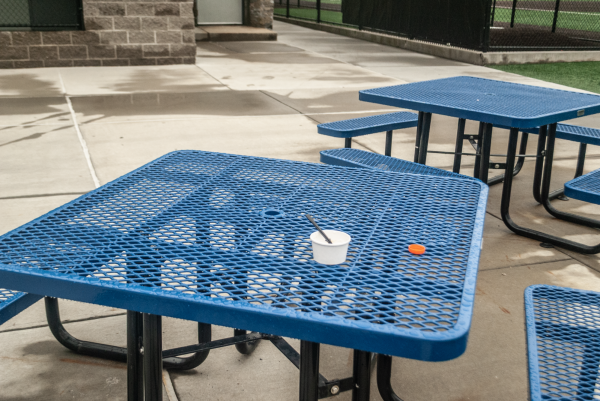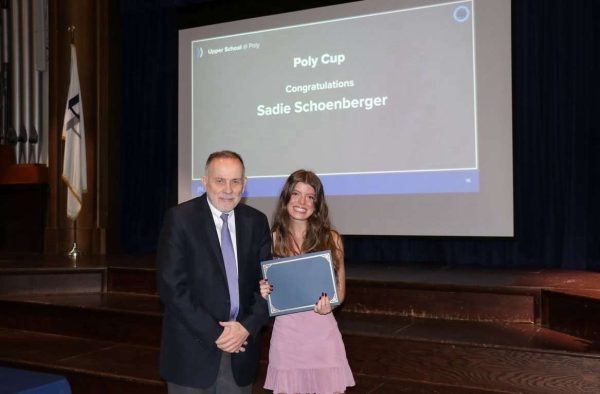Back to School … With A Reconstructed Schedule
Poly introduces a seven-day schedule with the return of in-person learning
While some aspects of school haven’t changed all that much from last year—the mask mandate, outdoor dining, reimagination of certain spaces—this school year includes a full return of in-person learning, competitive sports, arts performances, assemblies, and more that our student body has missed for over a year. However, one new thing has emerged post-pandemic—Poly’s seven-day schedule.
Prior to the pandemic in 2019, Poly ran on a 10-day schedule; last year due to Covid, it shifted back to five days. This year, classes run on a seven-day cycle with eight class blocks. There are now five 70-minute long class periods per day, with a half an hour break for lunch and five minutes of passing time in between each class.
When asked about the 70-minute class periods, Assistant Head of School Michal Hershkovitz said, “The process of considering and weighing different academic schedules that would align with our values and priorities as a school—including courses that challenge students to think deeply rather than simply regurgitate content, DEIB engagement, time for arts and athletics activities which are so important to the development of a meaningful life, here at Poly and beyond—took over a year. During that time, we learned a lot about the benefits and costs of longer class periods and decided that they were essential to helping students enter that zone of focus that is a precondition for long-term learning, retention of knowledge, and skill building.”
Additionally, the start of school has been pushed back from 8:30 a.m. to 9:00 a.m. to account for students’ sleep schedules. First period began at 9:00 a.m. last year as well due to the pandemic; however, Poly decided to retain the new start time. The end of school was consequently extended to 3:40 p.m.
Head of Upper School Sarah Bates added, “What we learned through the pandemic and a variety of research on teenage brain development is that the circadian rhythms of adolescents are different from that of adults. Teenagers have a tendency to stay up later and, therefore, wake up later. We wanted to maximize the time when high school students’ brains are ‘turned on’ and ready to engage in learning.”
Another new component to the schedule is the addition of an eighth block. Previously, students could only take up to seven classes, which left little freedom in choosing courses between the course requirements and extensive list of electives. The inclusion of an extra block has opened up more opportunities for students to explore new courses and disciplines.
The new schedule also promotes an entirely new lunch plan. In past years, every student of a particular grade ate lunch together at the same time every day in Commons. The schedule has shifted to include multiple different daily lunch times: one at 11:30 a.m. and the other at 12:05 p.m.. The latter is slightly more complicated; students attend their third period class for 35 minutes, leave to eat lunch, and return at 12:35 for the last 35 minutes. Additionally, students do not eat lunch at the same time every day like they have been used to. On Day 1, a student may have lunch at 11:30, but on Day 5, they might have what students have been calling “split lunch.”
Linda Russo, a mathematics teacher, has been teaching at Poly Prep for 17 years. Through her experience as an educator, Russo has grown accustomed to the consistent schedule changes often imposed by Poly Prep. When asked about potential challenges of adjusting to schedule, she said, “For this particular schedule, the hardest adjustment is coming off of remote learning to a seven day rotation where the periods are not all the same length.”
To new students or to students who were previously adjusted to former schedules, the introduction of 70 minute periods along with a seven-day rotation may be initially confusing or challenging to memorize.
As an educator who teaches split block classes, Russo has adjusted her structure of these periods to make them engaging for her students. She said, “for my higher courses, I break the period into two smaller lessons.”
With the stimulating element of lunch between Russo’s split block periods, she maintains a focused environment through this technique. Therefore, by creating smaller lessons to fit the structure of split block classes, Russo’s students obtain the ability to feel refreshed and ready to learn when re-entering her classes.
Ella Nelson-Adams is a sophomore who has been attending Poly Prep for 14 years. Throughout her fourteen years, Nelson-Adams has adjusted and experienced various schedule changes. To reflect on the 70-minute class periods, Nelson-Adams said, “Throughout my time at Poly, I have experienced 30-, 45-, 50-, and now 70-minute class periods. Although the 9:00 a.m. start is allowing me to get more sleep, as an individual with ADHD, I find it hard to sometimes stay productive throughout the entire period, and I get very tired. I appreciate when teachers give us breaks throughout the class because it helps me feel more engaged.”
For students previously adjusted to shorter class periods, a 70-minute long class can result in a loss of focus, therefore adding to overall exhaustion accumulated throughout the school day.
“I appreciate all of the positive intentions from faculty in introducing the 70-minute periods,” said Nelson-Adams. “Part of being a Poly Prep community member is adapting to change. I look forward to the remainder of the year as teachers continue to adjust their class structure to make the most of the new 70-minute classes.”

Carly Pyles ‘22 is the current Editor-in-Chief of the Polygon. She joined the staff during her sophomore year and became the Opinions Editor in her junior...

Charlotte Roberts is a current Head Layout Editor for the Polygon. Charlotte has been a layout editor for two years and has written for the Polygon for...



























